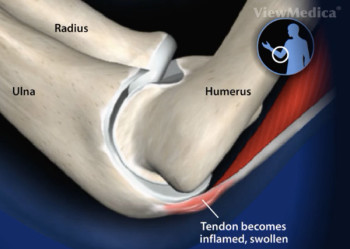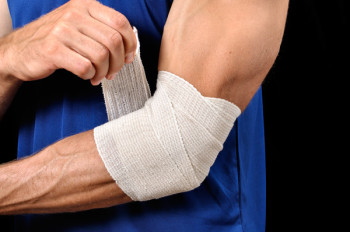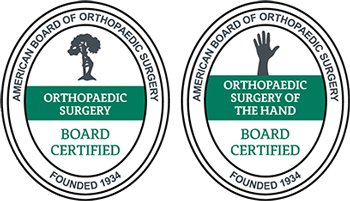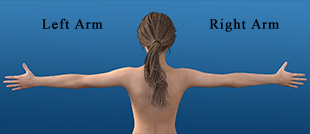Triceps Tendonitis
Contents
What is Triceps Tendonitis?

Tendons are a type of connective tissue that attaches muscle to bone, allowing movement to occur. The triceps muscle begins at the shoulder joint and extends down the back of the arm to the elbow. At the elbow the triceps tendon unites the triceps muscle to the olecranon process (a bony bump at the base of the elbow). Triceps Tendonitis occurs when this tendon becomes inflamed.
What causes Triceps Tendonitis?
The two main causes of Triceps Tendonitis include overuse or traumatic injury. Overuse is most common and results from repetitive straightening or pushing the elbow. Activities such as hammering, forceful throwing, push-ups or bench press exercises are common causes of this disorder. The recurrent stress on the tendon produces damage and inflammation over time. In the case of trauma, a direct blow or extreme force beyond what the triceps tendon is able to endure can also lead to Triceps Tendonitis.
What are the symptoms of Triceps Tendonitis?
The most common symptom is elbow pain that usually gets worse with activity. In severe cases the pain may be present at rest, limiting mobility. Sometimes there is mild edema and/or weakness of the triceps muscle.
How is Triceps Tendonitis diagnosed?
In general, a thorough physical examination, medical history, review of symptoms and activities is sufficient to determine a diagnosis of Triceps Tendonitis. In some instances imaging studies such as x-rays, ultrasound, MRI or CT scans may be used to exclude fracture and assess the severity of the condition.
Treatment Options for Triceps Tendonitis

Non-Surgical
Rest, ice, compression, and elevation (commonly called the RICE protocol) should be employed during the initial two days of treatment. All activities that aggravate the site should be stopped. A cold compress may be applied to the affected elbow several times a day for about 15 to 20 minutes at a time. Light compression using a bandage and elevating the elbow above the level of the heart will also help to reduce swelling and pain. NSAIDs (non-steroidal anti-inflammatory drugs) such as naproxen, aspirin, and ibuprofen may help decrease pain and inflammation. Once the inflammation has subsided your physician may recommend special exercises to stretch and strengthen the tendon. It is important to allow proper recovery otherwise the Triceps Tendonitis will likely re-occur.
Surgical
Surgical intervention is required if the elbow does not respond to conservative treatment or if the tendon is ruptured. The procedure may include repair or replacement of the triceps tendon and reattachment of the tendon to the bone. The arm is immobilized in a cast or splint post-operatively to protect the site and allow proper healing.
Why See Dr. Knight?
Dr. John Knight is a board certified orthopedic surgeon with over 25 years experience. He has performed more than 15,000 procedures involving conditions of the hands and arms. In addition to his experience, Dr. Knight has completed extensive training and has served on numerous medical boards. He currently serves as director of the Hand and Wrist Institute at D.I.S.C with experience, skill and compassion, Dr. Knight offers the highest quality treatment, from diagnosis and at-home care of your triceps tendonitis, to pain management, advanced surgical procedures and ultimate rehabilitation.
Our offices are easily accessible from Dallas and Dr. Knight is considered one of the top hand doctors in Dallas, TX. Come to our Dallas office or Southlake office to see what he can do for you.
Triceps Tendonitis Fact Sheet
| Are there any medications I can take to treat tendinitis? | Tendinitis is typified by microtears in the tendon, and so it not an inflammatory condition, otherwise NSAIDs would be effective in reducing some of the swelling and discomfort. If any thing, painkillers might be necessary to treat more serious cases of the condition due to the pain of the injury to the tendon |
| How does conservative treatment of tendinitis look? | Tendinitis is generally treated by utilizing the RICE protocol. Rest, Ice, Compression, and Elevation are the four most important aspects of this protocol, and if followed carefully and assiduously, can almost guarantee a positive result in alleviating the symptoms of tendinitis, whether in the triceps or other parts of the arm. |
| How can I avoid developing tendinitis? | The most important part of any athletic activity is the warmup, and this isn't just an old wives' tale; if proper exercises are undertaken prior to strenuous activity, then the micro-tears that lead to tendinitis can be avoided, as can the pain and discomfort associated with it. |
Frequently Asked Questions:
What can I do at home to help reduce the pain or discomfort of triceps tendinitis?
Triceps tendon injuries can be alleviated by exercises that fall under the same general category as exercises designed to strengthen the triceps muscle, so resistance presses, push-ups, and kick-backs can all be effective in strengthening the triceps tendon and lowering the incidence of damage and pain. Obviously, if these exercises are not done properly or the muscle and tendon are still overused, then they will not be helpful and the damage that leads to the condition will still be done.
What is the recovery time from triceps tendinitis?
Recovery time for triceps tendinitis varies depending on the severity of the condition and the method used to treat it. Conservative treatment of the illness may stretch on for a long time, possibly as long as you remain active, so as to stave off the worsening of symptoms already present. Corticosteroid injection may be briefly effective, but the condition will eventually progress over time. Surgical intervention will usually consist of repair, as it is only indicated if the tendon itself ruptures, which is a much more serious iteration of the condition than the discomfort of its earlier stages.
Can tendinitis go away on its own?
Tendinitis can seem to go away over time, and its symptoms may wane, but in reality, tendinitis quietly evolves into tendonosis, which is a much more serious condition typified by the breakdown of the tissue, a far more dangerous issue than simple tears in the tendon. Leaving tendinitis to heal itself is not recommended, and medical intervention is the best and most effective way to remedy the situation.
Animated Videos
Disclaimer
HandAndWristInstitute.com does not offer medical advice. The information presented here is offered for informational purposes only. Read Disclaimer

























